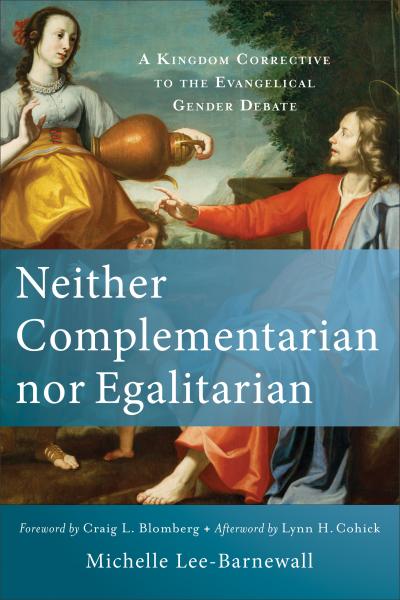Neither Complementarian nor Egalitarian

April 12, 2016
My spellcheck has never recognized complementarian as a real word. But in the circles I run in, I am considered extremely suspect if I don’t identify myself as one. It’s a fairly new term, coined less than thirty years ago. As I have been digging deeper into the movement behind this word, I am finding that it carries different implications depending on who is using it. I have been called a thin complementarian for questioning some teaching from the leaders of the movement that as a woman I am to be constantly looking for and nurturing men to lead me. (To which I responded here.)
 Within the culture in the church today, many questions are still being asked about the equality of men and women and where and how women can serve. As I have been participating in this conversation, I feel like I need to continue to begin with my convictions that Scripture places the responsibility of the ordained office on particular, qualified men, so that I am not labeled a feminist and dismissed. While I’ve been working on a book project of my own on related issues, I have found this new book out from Michelle Lee-Barnewall, Neither Complementarian nor Egalitarian. In the conservative, Reformed-ish community, a title like that is like saying that you don’t identify as male or female. So of course I had to read it.
Within the culture in the church today, many questions are still being asked about the equality of men and women and where and how women can serve. As I have been participating in this conversation, I feel like I need to continue to begin with my convictions that Scripture places the responsibility of the ordained office on particular, qualified men, so that I am not labeled a feminist and dismissed. While I’ve been working on a book project of my own on related issues, I have found this new book out from Michelle Lee-Barnewall, Neither Complementarian nor Egalitarian. In the conservative, Reformed-ish community, a title like that is like saying that you don’t identify as male or female. So of course I had to read it.Lee-Barnewall aims to offer a kingdom corrective to the evangelical gender debate, as stated in her subtitle. She begins the book saying that we need to take a few steps back from our current conversations and debates to recognize how the terms we are using are the product of cultural forces of the era in which we live. She makes the case that our discussions on gender weren’t always framed with vocabulary such as “authority”, “equality”, and “rights.”
So in Part One of the book, the author gives us a history of gender in evangelicalism, showing how women played different roles according to the cultural values of the time. At the turn of the nineteenth century, women were seen as important influencers and leaders in the wider cultural sphere, and were pioneering leadership roles in benevolence movements and missions. Their work in society was seen as imperative to the welfare of the country. After World War II, the woman’s sphere was narrowed to the private home. As culture became more industrialized, women were looked at as the holders of virtues such as “private benevolence, personal manners, and female sexual propriety”, with which they were to model by providing a haven for the men in their families (22). Women’s virtue and identity were tied to their roles as wives and mothers. And then came the 60’s and 70’s, where “heightened concerns about justice and civil rights created a fertile environment for egalitarians to challenge this situation and advocate for civil rights” (64).
Part Two of Lee-Barnewall’s book challenges the reader to step back from all this cultural baggage and read Scripture with an awareness of our own presuppositions. She suggests that we are reading for answers about who gets authority in what and whose rights are being infringed upon, all the while missing the main points of some key passages. The author doesn’t want to diminish the necessity of addressing some of those questions, but strongly suggests that both complementarians and egalitarians are putting the cart before the horse. Foremost in her teaching is that what our discussions are missing is the complete reversal of the kingdom of God contrasted to how society sees power, headship, and rule:
The point is not so much whether hierarchies are present as it is what they mean. In the kingdom, values of power and privilege are turned upside down, and they are upended according to the new values of the kingdom as seen in Christ himself. Christ’s statements such as “the last shall be first, and the first last” (Matt. 20:16) and “whoever wishes to be first among you shall be slave of all” (Mark 10:44) are integral to our understanding of any “hierarchies” in the kingdom. As we will see, the reversal of hierarchies is a prominent way in which the power of God is displayed in the kingdom as well as a vital means to promote unity and community.” (92)
You may read this and think, “Well sure, Christians talk about servant leadership all the time.” Lee-Barnewall critiques the way we do that though, saying that too often, when we discuss servant leadership, servant is used more as a modifier for leadership. Whereas, Scripture emphasizes sacrificial service, even in comparison with a slave, as what is a “necessary basis” for leadership. As we see in Scripture, God prefers to work through weakness rather than what the watching world thinks is strong. And so “leaders exemplify the way in which the new age is based on the cross and weakness and create a community whose members relate to one another in this way” (118). This type of reversal requires a dependence on God’s strength rather than our own.
I plan to post more on details of what Lee-Barnewall teaches about how this reversal plays out in headship and marriage, as this quick summary is becoming lengthy. But as a reflection, I think we would all affirm this paradoxical teaching about authority and leadership in Scripture, and yet, we so often don’t see leadership characterized this way in our own evangelical culture. Lee-Barnwell pleads that our theology of ministry for both men and women “should be able to show how the ministry of leaders points toward God, not the leaders themselves, and highlights the power of the cross, not just personal areas of competence and responsibility”(168). What I see so often is clamoring of the loudest and most highly paid voices to claim who gets to lead and who has to submit, while the pastors and husbands who truly understand headship are quietly taking out the trash and wiping runny noses.




